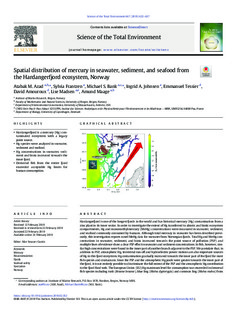| dc.description.abstract | Hardangerfjord is one of the longest fjords in the world and has historical mercury (Hg) contamination from a zinc plant in its inner sector. In order to investigate the extent of Hg transferred to abiotic and biotic ecosystem compartments, Hg and monomethylmercury (MeHg) concentrations were measured in seawater, sediment, and seafood commonly consumed by humans. Although total mercury in seawater has been described previously, this investigation reports novel MeHg data for seawater from Norwegian fjords. Total Hg and MeHg concentrations in seawater, sediment, and biota increased towards the point source of pollution (PSP) and multiple lines of evidence show a clear PSP effect in seawater and sediment concentrations. In fish, however, similar high concentrations were found in the inner part of another branch adjacent to the PSP. We postulate that, in addition to PSP, atmospheric Hg, terrestrial run-off and hydroelectric power stations are also important sources of Hg in this fjord ecosystem. Hg contamination gradually increased towards the inner part of the fjord for most fish species and crustaceans. Since the PSP and the atmospheric Hg pools were greater towards the inner part of the fjord, it is not entirely possible to discriminate the full extent of the PSP and the atmospheric Hg contribution to the fjord food web. The European Union (EU) Hg maximum level for consumption was exceeded in demersal fish species including tusk (Brosme brosme), blue ling (Molva dypterygia) and common ling (Molva molva) from the inner fjord (1.08 to 1.89 mg kg−1 ww) and from the outer fjord (0.49 to 1.07 mg kg−1 ww). Crustaceans were less contaminated and only European lobster (Homarus gammarus) from inner fjord exceeded the EU limit (0.62 mg kg−1 ww). Selenium (Se) concentrations were also measured in seafood species and Se-Hg co-exposure dynamics are also discussed. | nb_NO |
